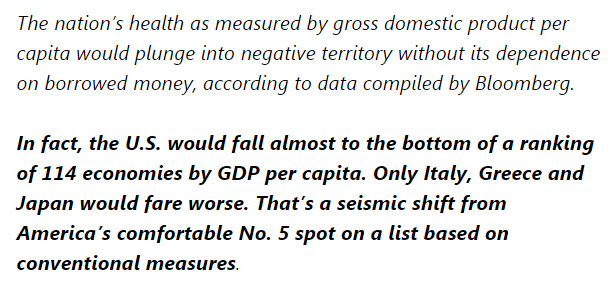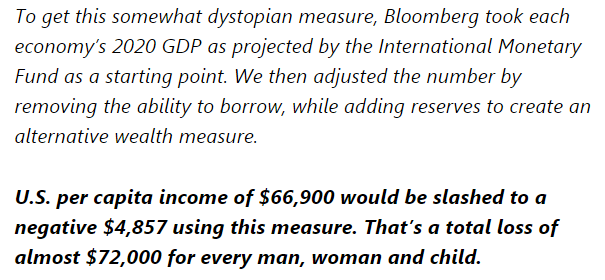Navigation
Install the app
How to install the app on iOS
Follow along with the video below to see how to install our site as a web app on your home screen.
Note: This feature may not be available in some browsers.
More options
You are using an out of date browser. It may not display this or other websites correctly.
You should upgrade or use an alternative browser.
You should upgrade or use an alternative browser.
Biden Signs $1.2 Trillion Infrastructure Bill Into Law
- Thread starter skews13
- Start date
Toddsterpatriot
Diamond Member
- May 3, 2011
- 102,224
- 36,249
Well, I gotta hand it to some, at least some are taking the cattle and sheep dewormer.
Wait, didn't Bill Gates put nano-tracking devices in ivermectin too?
You mean that awesome drug, successfully taken by billions since the 1980s?
Toddsterpatriot
Diamond Member
- May 3, 2011
- 102,224
- 36,249
Research from the Bloomberg. And sooner or later the debts will have to be paid

-

Imaginary numbers are very convincing.
LOL!
Ringo
Gold Member
- Jun 14, 2021
- 12,355
- 5,068
Imaginary numbers are very convincining
I know! But pieces of paper with dead presidents, drawn by the artists of the Fed in trillions, are a real deal!
Toddsterpatriot
Diamond Member
- May 3, 2011
- 102,224
- 36,249
I know! But pieces of paper with dead presidents, drawn by the artists of the Fed in trillions, are a real deal!
And?
Ringo
Gold Member
- Jun 14, 2021
- 12,355
- 5,068
Save your Confederate money, boys!And?
- Jan 15, 2009
- 65,677
- 40,932
Those were individual countries that russia took over by force.Should we also talk about USA, for example, as collection of puppet states?
Not even comparable to the USA. Not even a good deflection, but......
Toddsterpatriot
Diamond Member
- May 3, 2011
- 102,224
- 36,249
Save your Confederate money, boys!
How are those rubles doing?
- Jan 15, 2009
- 65,677
- 40,932
Comrade...may I call you comrade? There is no perfect country, but ours is way ahead of second place.I know! But pieces of paper with dead presidents, drawn by the artists of the Fed in trillions, are a real deal!
How is your country faring?

- Feb 24, 2021
- 20,597
- 10,160
Yes, that drug for roundworms, hookworms scabies, head lice and river blindness.You mean that awesome drug, successfully taken by billions since the 1980s?
Ringo
Gold Member
- Jun 14, 2021
- 12,355
- 5,068
A characteristic and distinctive feature of the Moscow state and the Russian Empire was indeed the voluntary entry into their composition of a number of peoples inhabiting huge areas: Belarus, Ukraine, Moldova, Georgia, Armenia, Kabarda, Kazakhstan, etc.Those were individual countries that russia took over by force.
Not even comparable to the USA.
The history of no other European or Asian empire knows anything like this. The Palace of Westminster, for example, has never seen an embassy within its walls that arrived with a request to include its country in the possession as a British colony. Same for White house. But scenes like this were not uncommon for the chambers of the Moscow Kremlin.
Toddsterpatriot
Diamond Member
- May 3, 2011
- 102,224
- 36,249
Yes, that drug for roundworms, hookworms scabies, head lice and river blindness.
Yes, the hugely successful drug, taken by billions.
Toddsterpatriot
Diamond Member
- May 3, 2011
- 102,224
- 36,249
the voluntary entry into their composition of a number of peoples
Voluntary?
Ringo
Gold Member
- Jun 14, 2021
- 12,355
- 5,068
They usually were begging for this.Voluntary?
Both during the period of the consolidation of Russian lands around Moscow in the XIV-XV centuries, and in the later era of the unification of non-Russian lands within multinational Russia, the same historical rhythm is traced, caused by the internal inconsistency of the integration process. Whether in Ryazan, near or in distant Kakheti, centripetal and centrifugal forces and aspirations operated simultaneously. From their confrontation, local "tides" to Moscow and "ebbs" from it were born alternately. It is easy to distinguish the general phases of such political cycles, which, repeating and fading, led to complete state unification:
1. an appeal to Moscow for military assistance;
2. help was received, and the crisis was overcome;
3. the military presence of Moscow (Russia) begins to weigh down, there is a desire to get rid of political dependence;
4. the restoration of the status quo with Moscow most often in alliance with former enemies;
5. resumption, as a rule, in a much more acute form of the old crisis;
6. return to Moscow.
The history of Ukraine's reunification with Russia is a clear example of this.
Bogdan Khmelnitsky, like the cossack leaders before him, repeatedly appealed to Russia with a request for accession. (16 times he sent to Moscow embassies with a plea to join Russia). The Moscow government hesitated for a long time and, no matter how autocratic it was, did not decide on its own, without advice "from all over the land", to start a war against the strongest Polish Commonwealth. Two Councils representing all estates of Russia were convened in 1651 and in 1653.
Moscow's hesitation and indecision are more than understandable: relations between Poland and Sweden, which blocked Russia's access to the Baltic, have heated up to the limit. The gap between them became inevitable, which gave the tsar the opportunity to finally resolve the Livonian question in alliance with the Polish-Lithuanian Commonwealth. After heavy defeats, Muscovy was saving up its fighting forces precisely for the fight in the Baltic States, and here is a plea for help from the tormented Ukraine!
Nevertheless, the Zemsky Sobor of 1653 speaks out for the adoption of "Small Russia" (Ukraine) under the high hand of the sovereign of all Russia," and barely strengthened Russia, after the ruin of the early 17th century, re-enters the war, which lasted 14 years!. The strike of the tsarist troops in the Belarusian direction chained the main Polish forces there, which allows the Cossacks to clear the whole of Ukraine from the polish lords. The second phase is completed, the third begins.
The successor of Bogdan Khmelnitsky, Hetman Vygovsky, raises a call for independence against the "Muscovites" in Ukrain cities, which sometimes expel them with an armed hand. He himself, together with the Crimean khan, smashes the Moscow cavalry under Konotop. After such a victory, "independence" in relation to Moscow immediately turns into dependence on Poland, which is in a hurry to recognize the privileges of the Cossack elders in order to return ordinary cossacks and the ukrainian peasantry to the polish oppression. Everything goes back to "normal."
A new cycle begins. The "black Rada", that is, one where "black (ordinary) people" are present, throws off Vygovsky, elects Yuri Khmelnitsky as hetman, plea before the tsar about the resumption of the "articles" of the Pereyaslav Rada ( The place where in 1654 was declared on unification with Russia) and about help against Poland. The Moscow army re-enters Ukraine, but it, too, betrayed by the Cossack elite, is forced to capitulate to the Poles at Chudnov (1660).
Then there were new Meetings, new hetmans (sometimes two, three at a time), new petitions and new treasons. It came to the point that the Crimean tatars, these "loyal allies in the struggle for independence", did not hesitate to exchange captured ukrainian girls and women right under the windows of the hetman's house. Torn apart by internecine strife, Ukraine was one solid ruin. Later, Ukrainian historians will call this troubled period just "Ruin".
And here is the way out of the turmoil and the end of the last cycle.
Ukrainian cities are asking the Moscow government to send troops into them. Moscow, referring to past "theft and treason," refuses. Then the ukrainian burghers ask the tsar to rule them "according to his sovereign will" in the same way as all other cities of the kingdom. In other words, the "articles" of the Pereyaslav Rada guaranteeing self-government within the boundaries of Magdeburg law for Ukrainian cities are crossed out by Ukrainians themselves.
On these conditions, that is, on the conditions of unconditional submission, tsarist Russia returns to Ukraine. Now Ukraine will not be afraid of any traitor: neither the townspeople nor the cossacks will follow him. He will become, first of all, the enemy of the ukrainian people themselves.
50 years later, when the Swedish king Charles XII invaded Ukraine, the traitor Hetman Mazepa promised him the support of the entire ukrainian people in the war with Russia, but only a miserable part of the Cossacks followed him. The Ukrainian people opposed the Swedes.
Last edited:
Toddsterpatriot
Diamond Member
- May 3, 2011
- 102,224
- 36,249
They usually were begging for this.
Were they still begging in 1991?
Ringo
Gold Member
- Jun 14, 2021
- 12,355
- 5,068
Did someone keep them then? In 1991, there were traitors in power in both Russia and Ukraine. They agreed.Were they still begging in 1991?
Toddsterpatriot
Diamond Member
- May 3, 2011
- 102,224
- 36,249
Did someone keep them then? In 1991, there were traitors in power in both Russia and Ukraine. They agreed.
Did someone leave then?
Ringo
Gold Member
- Jun 14, 2021
- 12,355
- 5,068
No, USSR still intact.Did someone leave then?
Toddsterpatriot
Diamond Member
- May 3, 2011
- 102,224
- 36,249
No, USSR still intact.
LOL!
- Feb 24, 2021
- 20,597
- 10,160
Billions more taken by horses, cattle and sheep.Yes, the hugely successful drug, taken by billions.
My guess would be the latter.
Similar threads
- Replies
- 112
- Views
- 1K
- Replies
- 7
- Views
- 210
- Replies
- 60
- Views
- 1K
Latest Discussions
- Replies
- 87
- Views
- 440
- Replies
- 7
- Views
- 17
Forum List
-
-
-
-
-
Political Satire 8513
-
-
-
-
-
-
-
-
-
-
-
-
-
-
-
-
-
-
-
ObamaCare 781
-
-
-
-
-
-
-
-
-
-
-
Member Usernotes 483
-
-
-
-
-
-
-
-
-
-